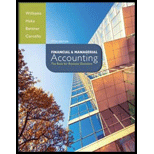
a.
Identify the project that would be chosen by Person B for investment, if Person B’s objective were to maximize the location’s
a.
Explanation of Solution
Return on investment (ROI): This financial ratio evaluates how efficiently the assets are used in earning income from operations. So, ROI is a tool used to measure and compare the performance of a units or divisions or a companies. The formula for ROI is as follows:
The projects that are having ROI greater than or equal to 14% would be attractive to Person B and would improve the ROI of Person B’s location. Project A-1 and A-2 are having ROI of 14.1% and 20.0% respectively, which would be attractive to Person B to improve the ROI of the current location.
b.
Identify the project that would increase the value of Incorporation F.
b.
Explanation of Solution
Return on investment (ROI): This financial ratio evaluates how efficiently the assets are used in earning income from operations. So, ROI is a tool used to measure and compare the performance of a units or divisions or a companies. The formula for ROI is as follows:
The projects that are having ROI above the minimum required return established for Incorporation F of 12% would increase the value of Incorporation F. Projects A-1, A-2, A-3, and A-4 are likely to increase the value of Incorporation F. However, Project A-5 would not be acceptable.
c.
Identify the project that would have a negative residual income.
c.
Explanation of Solution
Residual income: Residual income is the excess of income over the minimum acceptable return on average capital invested. The minimum
Return on investment (ROI): This financial ratio evaluates how efficiently the assets are used in earning income from operations. So, ROI is a tool used to measure and compare the performance of a units or divisions or a companies. The formula for ROI is as follows:
Determine the residual income (loss) of each project.
| Project | Operating Income | Residual Income (loss) |
| A-1 | ||
| A-2 | ||
| A-3 | ||
| A-4 | ||
| A-5 |
Table (1)
As per Table (1), Project A-5 is having residual income (Loss) of ($11,000).
d.
Create two rankings for the projects in order of acceptability if Person B is evaluated (1) on ROI and (2) on residual income.
d.
Explanation of Solution
Residual income: Residual income is the excess of income over the minimum acceptable return on average capital invested. The minimum rate of return shows the opportunity cost of using the invested capital. The formula for residual income is as follows:
Return on investment (ROI): This financial ratio evaluates how efficiently the assets are used in earning income from operations. So, ROI is a tool used to measure and compare the performance of a units or divisions or a companies. The formula for ROI is as follows:
Rank the projects in order of acceptability based (1) on ROI.
| Project | Required capital | ROI | Ranking |
| A-1 | $150,000 | 14.1% | 2 |
| A-2 | $300,000 | 20.0% | 1 |
| A-3 | $250,000 | 13.5% | 3 |
| A-4 | $400,000 | 12.5% | 4 |
| A-5 | 500,000 | 9.8% | 5 |
Table (2)
On the basis of ROI, Project A-2 and Project A-1 would be acceptable by Person B because the ROI yields 14.1% and 20.0% respectively which is higher than the current ROI of 14%.
Rank the projects in order of acceptability based (2) on residual income
| Project | Operating Income | Residual Income (loss) | Ranking |
| A-1 | 3 | ||
| A-2 | 1 | ||
| A-3 | 2 | ||
| A-4 | 4 | ||
| A-5 | 5 |
Table (3)
On the basis of residual income, Project A-2 and Project A-3 would be acceptable because the residual income is $24,000 and $3,750 respectively which are higher than the residual income of other projects.
e.
On the basis of the projects, explain the reasons behind the problem of under –investment using ROI as a tool of evaluation.
e.
Explanation of Solution
As per Table (2), the Project A-1 would be preferred over Project A-3 because Project A-1 yields a ROI of 14.1% which is higher than the current ROI of 14%. On the other hand, Project A-3 yields a ROI of 13.5% which is lower than the current ROI of 14%.
As per Table (3), the Project A-3 would be preferred over Project A-1 because the residual income from Project A-3 is $3,750 with an invested capital of $250,000. On the other hand, the residual income from Project A-1 is $3,150 with an invested capital of $150,000. The residual income of Project A-3 is higher than the residual income of Project A-1.
If Person B is evaluated on the basis of ROI, then Project A-1 or Project A-2 would be considered because they are the projects that would raise the current ROI of 14%.
Want to see more full solutions like this?
Chapter 25 Solutions
Financial & Managerial Accounting

 AccountingAccountingISBN:9781337272094Author:WARREN, Carl S., Reeve, James M., Duchac, Jonathan E.Publisher:Cengage Learning,
AccountingAccountingISBN:9781337272094Author:WARREN, Carl S., Reeve, James M., Duchac, Jonathan E.Publisher:Cengage Learning, Accounting Information SystemsAccountingISBN:9781337619202Author:Hall, James A.Publisher:Cengage Learning,
Accounting Information SystemsAccountingISBN:9781337619202Author:Hall, James A.Publisher:Cengage Learning, Horngren's Cost Accounting: A Managerial Emphasis...AccountingISBN:9780134475585Author:Srikant M. Datar, Madhav V. RajanPublisher:PEARSON
Horngren's Cost Accounting: A Managerial Emphasis...AccountingISBN:9780134475585Author:Srikant M. Datar, Madhav V. RajanPublisher:PEARSON Intermediate AccountingAccountingISBN:9781259722660Author:J. David Spiceland, Mark W. Nelson, Wayne M ThomasPublisher:McGraw-Hill Education
Intermediate AccountingAccountingISBN:9781259722660Author:J. David Spiceland, Mark W. Nelson, Wayne M ThomasPublisher:McGraw-Hill Education Financial and Managerial AccountingAccountingISBN:9781259726705Author:John J Wild, Ken W. Shaw, Barbara Chiappetta Fundamental Accounting PrinciplesPublisher:McGraw-Hill Education
Financial and Managerial AccountingAccountingISBN:9781259726705Author:John J Wild, Ken W. Shaw, Barbara Chiappetta Fundamental Accounting PrinciplesPublisher:McGraw-Hill Education





